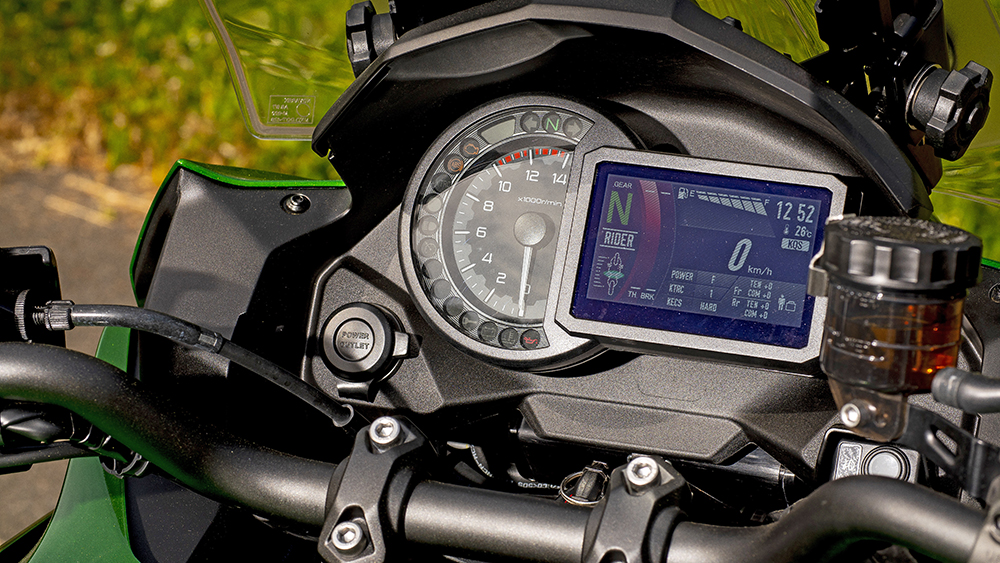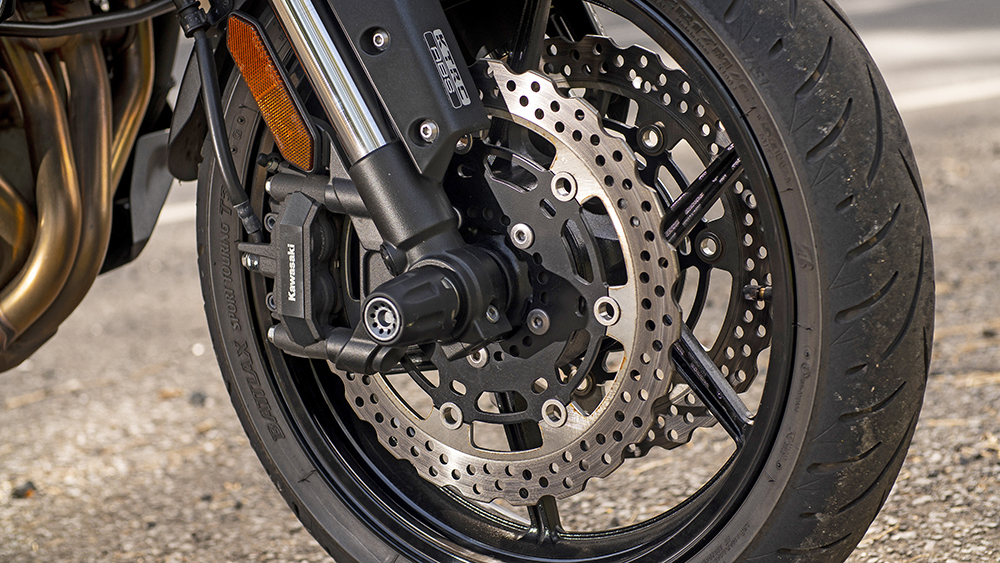Well, hasn’t the 1000 Versys come a long way? The 2012 version, with its stacked headlights, seemed a little career-confused, something Kawasaki sorted out with the new version in 2015. It was well priced ($16,299 as we speak), well equipped and nailed the long-distance, sports-touring brief well, including the luggage carrying ability such a bike requires. There was a lot to like about the standard Versys, even if the name itself takes a bit to absorb.
For 2019, the bike has taken an aggressive step towards its European competitors by adding, amongst other things, a full swag of IMU-driven electronics, a full-colour TFT dash and semi active suspension, including electronically activated rear pre-load, and radial mounted brake calipers – and of course a price upgrade to allow that level of sophistication.
For some, the move away from the bargain-priced Versys 1000 is controversial – part of its appeal is its bang for buck. The $22,499 +ORC Versys 1000 SE is still good value, even if it is more expensive – it just depends on how much you want that electrickery.
Just look at that Kawasaki Electronic Control Suspension (KECS) that works its semi-active magic on the long travel suspension (think ‘all roads’, not ‘off road’) – it’s feature packed, it works and it’s easy to play with via the switch gear. Then there’s the LED cornering headlights, the flawless up-and-down quickshifter, the same epic ABS system as on the Ninja H2 and ZX-10R, the stonking 400-plus kilometre touring range, the standard DC socket on the dash and the cruise control. The $27k (as tested) price tag starts to make sense.
Experience has told me, however, that all that fruit does not a perfect basket make, if it doesn’t play well together. Any great bike is the sum of its parts, not just what the marketing team may have asked to be bolted on.
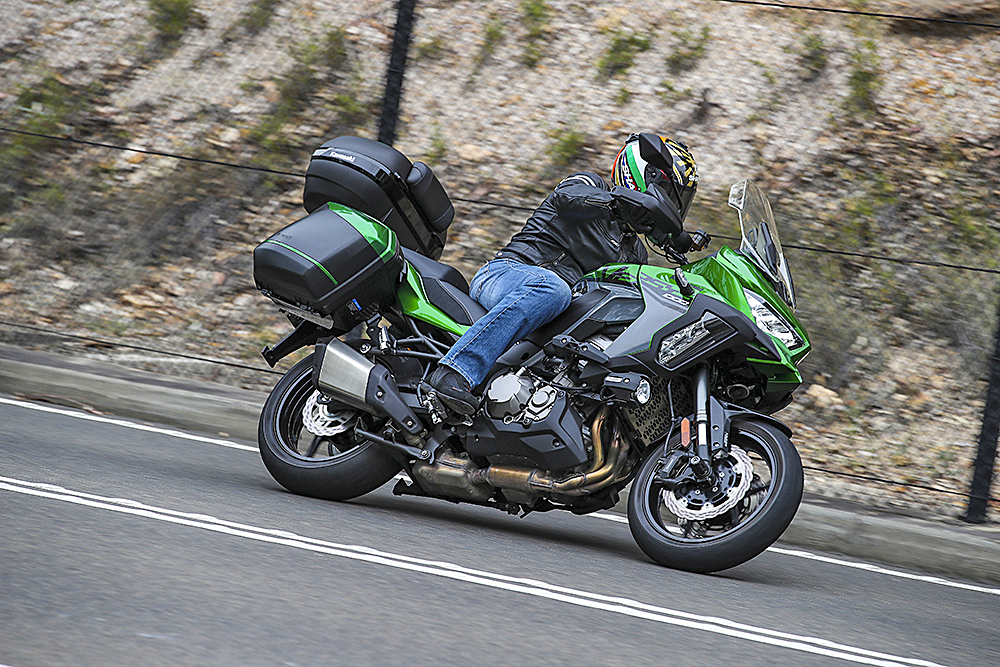
The main focus for me is the suspension, given it’s a big change from what worked well on the standard bike. Minutes after picking the bike up, I noticed the bars would wiggle as I pulled up and the front end didn’t feel as solid as it usually does on this bike. Checking the TFT dash as I sat at the lights, the icon told me the rear preload was in bike and luggage mode, i.e, more rear spring preload, yet I had nothing in the panniers or the topbox.
In the past, I have run bikes with this option (Ducati Multistrada S, for instance) in pillion or luggage mode for better feel in sporty riding. For this Versys, I quickly thumbed through to rider-only preload mode and, seconds later, had a more stable, better feeling one-up machine.
The seat felt like it dropped two inches as the servo motors did their job on the spring preload, taking weight off the front and reducing the fork angle, too. This is a good thing – add meaningful kilos to the luggage, as intended, and the bike will adapt to keep the bike level and sweet steering. Two days later, I had a bike launch at a track, so the leathers went in the topbox, as did gear for three days away – pushed the buttons and I had a level, well-mannered motorcycle, all loaded up.
Laying it over, pannier-equipped and all, and the Versys feels solid and well balanced – so much so I was surprised when my boot hit the deck, it just didn’t feel like I was that far over. Its competition does that too, but where the Ducati and KTM are all rorty with it, the Kawasaki is effortless, smooth and just so refined. The KECS plays a part here, as does that engine. You can even set a custom rider mode, to suit yourself.
The engine- and chassis-feel match each other really well, thanks to that semi active suspension toiling away under your butt, honing the ride as you motor through a range of road situations. I chose the ‘Hard’ option in the settings, which remained very compliant, but just what I wanted from a long-legged touring bike.
Heavier or faster riders will definitely be diving further into the damping parameters on offer to firm it up, as it is plush. I still enjoyed the control on offer, though, and will take plush over harsh any day. For me, the long-travel suspension gives the chance to really remove yourself from the worst of the road acne, and the Versys let me do exactly that.
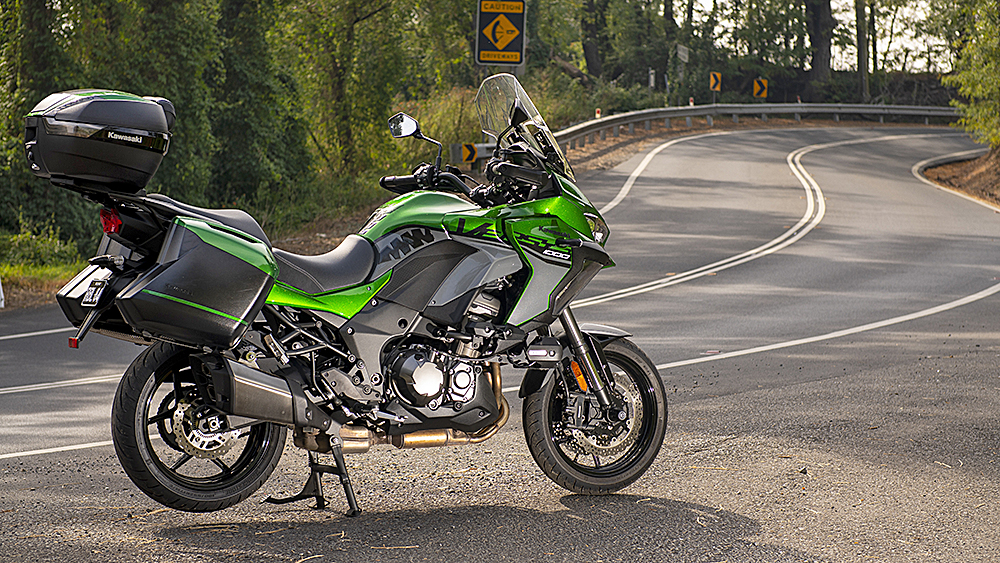
The suspension adjustments are very simple to make using the left-hand switch gear, I figured it out in a minute or two without a manual, which is always a good sign. The rear preload adjustments do have a big effect on the bike’s handling, as mentioned earlier, so it’s worth ensuring you
have that sorted each time you change the conditions the rear shock has to deal with – simple and fast to do.
As mentioned earlier, the Kawasaki doesn’t have the top end of the Ducati, KTM or BMW, but smaller engines can often be sweeter and that is the case here. There’s still more than enough for a touring roadbike – overtaking is simple, you get a rush from pumping hard away from the lights and it will chug away in a single tall gear, if you don’t feel like bothering with the powershifter.
If you want big gobs of adrenalin-peaking horsepower, the Versys 1000 isn’t your machine. But if you are realistic about the power needed to traverse this country effectively, its turbine-like delivery will deliver. It is so smooth and compliant; I never felt the need to shift power modes other than to see if they worked or not. They do, but the power is metered out so nicely, the full power mode – around 87kW (118hp), claimed – does the job.
Changing gear though – well, you will be looking for excuses to do so. This is one of the best up and down shifters on the market, in that it works even at lower traffic speeds, pops nicely at the exhaust from time to time and matches revs beautifully on the way down the gearbox. The ’box itself helps the technology, it’s got that feeling of precision Kawasaki does so well with its cog boxes, and shuffling between third and fifth gear along an open touring road is sublime. You can turn off the quickshifter, but yeah. Don’t.
The cruise control I was less enamoured with. It often didn’t hold the speed I set it on, dropping below what I set it at, just an annoying few km/h below, then over reacted when I thumbed it up to the speed I wanted. It cancelled fine and is easy to use, it’s just not as accurate as I’d like.
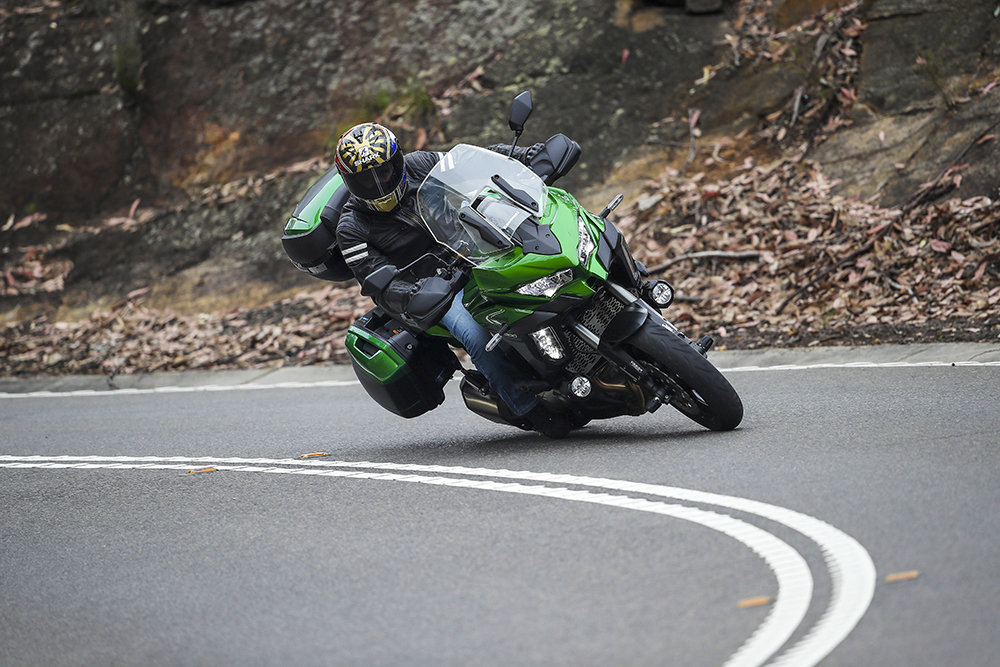
A 110km/h touring speed is effortless, and as mentioned with the screen up is a refined place to be sitting. The bike is still large and roomy – if you’re 185cm or so, this bike will fit you beautifully, though I was more than comfortable at 178cm tall. The nose protection is sweet and, while talking about that nose, it’s worth noting how good looking it is, particularly when compared with that strange, boxy nose it arrived with in 2012.
There’s no doubt it’s a Kawasaki now, and the brilliant lime green paint and graphics modernise it nicely, while the engine itself was clearly designed to be seen, with its nice lines and tidy look. It all worked, though again, its more expensive rivals have some impressive design cred, too.
The TFT dash is a beauty, though I wonder why the live throttle/braking pressure graphs are there – if you’re looking at them, you’re not watching the road… You can bring up your choice of two different screens depending on where you are riding, and I found it easy to read and use, with an accurate fuel gauge and large gear position read out. I also like how it uses a traditional tacho so well with the high-tech TFT arrangement – there’s just something about how a tacho swings around the dial I like – to be able to see that, along with the TFT screen, is how it should be done these days.
The Versys’s myriad components play so well together. Kawasaki mentions how the six-axis IMU (inertial measurement unit) allow the lean-angle sensitive electronics to play well together and it’s right, so when you add in an engine and gearbox that are so sweet, you have a very complete bike. Is it a $22,499 (plus on-road costs) bike, though? We had $4.5K worth of extra goodies thrown at ours, because all of that well-integrated luggage doesn’t come standard. If you want the luggage, and the sag of other bits and pieces (see sidebar) that’ll take the price out to $27,091 (plus on-roads), or thereabouts – for accurate pricing, plug your area into the price calculator on Kawasaki’s website.
It’s full fruit, that’s for sure, and it all works so beautifully together – cruise control excepted – that if you can live without another 40 horsepower and European looks, then yes, it has all you need to get you around the country comfortably and quickly. Forty extra horses are fun, but not essential, and the way those Kawasaki electronics and chassis work together to deliver a smooth, effortless ride, as well as a sweet engine that might lack silly top-end figures, but delivers everywhere else, mean there’s little real world performance missing from the package.
If you want semi-active suspension, the full package of high level rider aides, high build quality, a refined ride and one of the best seats in motorcycling, then look here. Don’t forget, too, that all the things that make this bike easy to live with, such as the mounting of the optional panniers, 400km+ fuel range, the perfect way the centerstand works and the bike’s roominess, adds value, too. This thing isn’t just slapped together. It’s a sweet, complete touring package, with more standard fruit than its more expensive competition.
